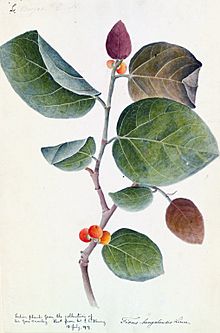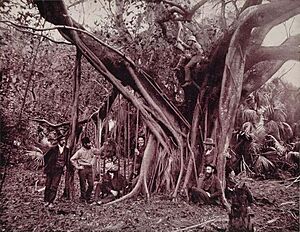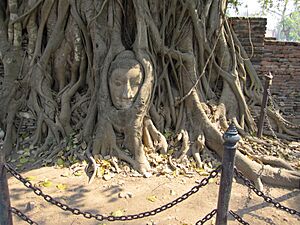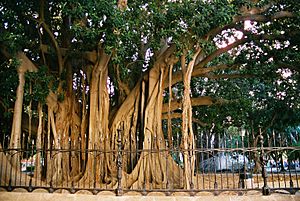Banyan facts for kids
Quick facts for kids Banyan |
|
|---|---|
 |
|
| Ficus benghalensis | |
| Scientific classification | |
| Kingdom: | |
| Division: | |
| Class: | |
| Order: | |
| Family: | |
| Genus: | |
| Subgenus: |
(Urostigma)
|
A banyan is a special type of fig tree. It often begins its life growing on another plant, like a host tree, or even on buildings and bridges. Its tiny seeds sprout in small cracks and spaces.
The name "banyan" usually refers to the Indian banyan (Ficus benghalensis). This tree is the National tree of India. However, the term "banyan" can also describe other fig trees that grow in a similar way. These trees belong to a group called Urostigma.
Birds that eat fruit help spread banyan seeds. When a seed sprouts, it sends roots down towards the ground. These roots can grow around the host tree or building. Because of this, banyans are sometimes called strangler figs. Many tropical forest trees grow this way, especially other types of Ficus trees. They compete for sunlight.
Contents
What a Banyan Tree Looks Like
Banyan leaves are big and strong. They are shiny green and shaped like an oval. Like most fig trees, the new leaf buds are covered by two large scales. These scales fall off as the leaf grows. Young banyan leaves often have a pretty reddish color.
Older banyan trees have special roots that grow down from their branches. These are called aerial prop roots. They become thick and woody, looking just like extra trunks. Over time, an old banyan tree can spread out very wide using these prop roots. They help the tree cover a huge area!
Just like other fig trees (including the common edible fig, Ficus carica), banyans have unique fruit. They need tiny fig wasps to help them reproduce.
How a Banyan Tree Grows and Changes its Host
Once the banyan's roots reach the ground, they start to absorb nutrients and grow much faster and thicker. These roots begin to wrap around the trunk of the host tree. The banyan's leaves and branches also grow big in the canopy, blocking sunlight from the host tree.
Without enough food and light, the host tree slowly dies. Its wood then breaks down because of beetles, termites, and fungi. What's left is a hollow space inside the banyan. The banyan's roots form a strong, hollow cylinder, and the tree stands tall on its own.
Sometimes, a banyan tree actually starts from several different seeds that sprouted on the same host tree. Scientists have found this out by studying their DNA.
Images for kids
See also
 In Spanish: Baniano para niños
In Spanish: Baniano para niños








